Greetings From A Place That Is Definitely Not The Biggest Music Destination In The World
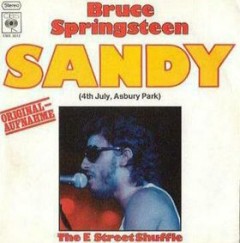
“Ms. Lipson tried to get a meeting with Madison Marquette’s president, Gary Mottola, for weeks to make her pitch. She finally got it on a recent morning in a sunbaked conference room. Ms. Lipson was in a black skirt and sleeveless top and big sunglasses, Mr. Mottola in a Stone Pony T-shirt; a reporter attended. Ms. Lipson noted that while New Jersey had many regional museums, it had nothing that drew international tourism. ‘Except Madam Marie,’ Mr. Mottola interjected, referring to the stand of a former boardwalk fortuneteller made famous by Bruce Springsteen in his ‘4th of July, Asbury Park (Sandy).’ Ms. Lipson said the museum would be an economic catalyst in the way that Mass MoCA, a contemporary art museum that opened in 1999, has been in North Adams, Mass. ‘It was blighted; there was a high crime rate,’ she said. Mr. Mottola appeared to take umbrage. Asbury Park, he said, was ‘the biggest music destination in the world.’”
–Interesting article in the Times about Robin Parness Lipson, who is trying to start a contemporary art museum on the Asbury Park Boardwalk, and who runs into a bit of resistance from a man whose company owns the old power plant building that she envisions as a site. As much kinship as I might feel for his sense of local loyalty, and as much as I respect anyone who takes business meetings in a Stone Pony T-shirt, I think Gary should maybe lay off the Bruce Juice for a minute.
The Zeitgeist Is Semeny

Perhaps chastened after being called out for their extremely questionable behavior last year, the folks at New York magazine are going to great lengths to establish ownership over the potential nickname for the 2010 sweaty season, which they are close to declaring the Summer of Semen. This appellation has apparently been inspired by the story of Michael Lallana, a California man arrested yesterday for “allegedly jerking off into a female co-worker’s water bottle, sickening her.” This story is creepy and gross, and I feel absolutely terrible about this, but this is a blog, and we are required by law to end at least five posts a month this way, so here goes: Have you ever been sickened after ingesting someone else’s semen? Tell us in the comments!
Here's Jerry!
Here’s Jerry! After ‘Work of Art,’ Saltz Keeps Chatting: “A Lot of People, of Course, Hate Art Critics”
by Alexandria Symonds
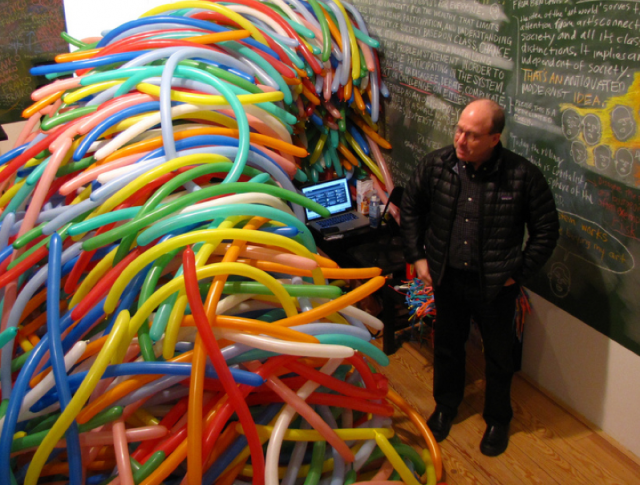
It’s been a week since Bravo’s “Work of Art” ended, and art critic and on-air judge Jerry Saltz’s final recap of the show for New York magazine’s Vulture blog has reached 436 comments. It’s rare, in the ADHD world of blog comments, to keep a conversation about any topic going for a full week. But a Bravo reality competition in its first season, whose average viewership across ten episodes was just 1.12 million viewers? A Bravo reality competition whose winner has already been decided? Were you still thinking about Harold Dieterle a week later? (Who? Exactly.)
In his last recap of the show, Jerry suggested that the comment threads on the site had given rise to a new way of talking about art: in the comments, “an accidental art criticism sprang up, practiced in a new place, in a new way, on a fairly high level,” he wrote.
That idea immediately rankled some in the art world, like critic Christopher Knight, who took serious issue with the idea that viewers could judge art based on a TV show. But it’s hard to argue with the strength of Jerry’s numbers. The interactive barrage started slow, but quickly gained speed: somehow, 39 comments on the first post paved the way for 510 on the eighth. Something was happening here.
To characterize that something, insofar as such a thing is possible: from what I can tell, it involved around a dozen regulars, who commented multiple times on each post, along with many more who dropped in only occasionally. Unlike typical threads on New York blogs, these commenters were not, for the most part, stopping by to make quick jokes or to casually react to posts. They were (and still are, it seems) fiercely opinionated about the show, the contestants, the works, the recaps, and each other. What’s more, some of the show’s contestants leaped into the fray, too-to defend their work, to criticize or compliment the work of others, or, in Nicole Nadeau’s case, to explain that her face appeared splotchy on camera because she was allergic to the show’s makeup.
And then, of course, there’s Jerry. His numerous comments, even if they do not redefine art criticism, must at least redefine prolificacy. Almost any commenter who made a bold assertion or asked a reasonable question was assured a somewhat considered response by one of the best art critics in New York-not a bad deal.
Jerry Saltz is not a man unacquainted with the subtleties of the Internet; he has a famously well-connected Facebook page. But the Vulture comments are different, and he’ll tell you so himself.
“On my Facebook… people have to behave, otherwise there’s an authority, me, that can get rid of them,” Jerry told me in an interview last week. “But on that stupid New York magazine page, you know, I wasn’t even the authority. Anybody could say anything, I don’t have any say. Nobody had to reveal their identity, except me, which made, I think, me more vulnerable and helped level the playing field.”
The playing field was about as level as it gets: it collapsed creators, critics, and viewers of art into one democratic space. In the comments, nothing besides their usernames distinguishes Jerry or the artists from the other commenters. Everyone’s opinions appear in the same font and the same size. Jerry balanced this equal aesthetic weight with an equal critical one by taking every comment seriously, and the results surprised even him.
“I knew the reason I got involved with this is to see if criticism could exist on a different stage,” he said. “But it never occurred to me that the stage that I would be on would be this kind of strange middle territory online. I’m still amazed. I don’t know what to do with it.”
* * *
Jerry’s recaps are unerringly honest, explaining all the divergences between his experience of the show and the finished product that Bravo delivered to cable TV every week. He wrote about editing decisions that may have been unfair; he wrote about the producers stopping filming to ask him to adjust his “hanging brains.” (Incidentally, that was the post that garnered the most comments, so far.) This alone was rather unusual for a reality competition that was still airing: usually, reality-show participants who want to criticize the shows they’re on have to wait until the threat of its hurting ratings has disappeared.
According to Jerry, Bravo didn’t care one way or the other. “I never read the contract, I never had an agent… So, I don’t know what the contract says. They haven’t said anything to me about it,” he said. To at least some extent, this is Bravo’s modus operandi-witness Simon van Kempen’s Twitter account during any airing of Real Housewives of New York, or Tom Colicchio’s discussion of “pea-puree-gate” on his Top Chef blog, or Bravo exec and on-air personality Andy Cohen’s network-sanctioned willingness to have a good time online. The Bravo scheme is to embrace the meta-narratives-it’s good for business!
On Vulture, Jerry is more or less a free agent-a sort of Pied Piper leading neophytes into the daunting world of art criticism. “We might have accidentally mapped out-might have occupied an unmapped area, kind of what I’m calling the ‘wilder shores of criticism,’” Jerry said, an idea he reiterated in his final recap.
“These outer banks where people that don’t normally have any access-to the power, the opinion, the mainframe of the art world-were suddenly involved,” he explained to me. “And it was coherent, as opposed to most blog comments sections, that just kind of like, you know, people write under anonymous names and they tear each other new assholes. And I love doing that, myself, but it’s a big mess.”
Jerry’s a self-effacing sort of guy who probably wouldn’t admit it, but this “multi-headed, non-hierarchical conversation” didn’t arise out of nowhere. His methods of addressing the commenters were crucial to the existence of any kind of coherency in the threads. Though he’s a professor, he insists he’s not the Socratic-method type-”My idea of teaching is I go in one-on-one with students in their studios and I yammer!” he said-but read through all the comments and you’ll have taken a crash course in art criticism, conducted in exactly that way.
While Jerry certainly answered a lot of questions, he also asked a lot of them. If a commenter had a bone to pick with the judges’ choice of elimination, Jerry might ask him who deserved to stay and why. If someone complained that none of the art in an episode was any good, he might ask her to name five works of art she enjoys, and why. Maybe flattered by the attention, or maybe because they had truly begun to engage with the work, commenters kept responding, to Jerry and to each other. The end result for any given episode is not wholly unlike a transcript of an unruly undergraduate seminar.
“I think that a kind of ‘survival of the clearest’ started happening,” Jerry said. “I think that people started instinctively understanding that if you write a giant block of type, even if you’re Albertine Einstein, no one’s going to read it! The time is different, the eye works different, there’s no intimacy between you and the page. It’s not like Artforum. So I think that people started actually making sense.”
* * *
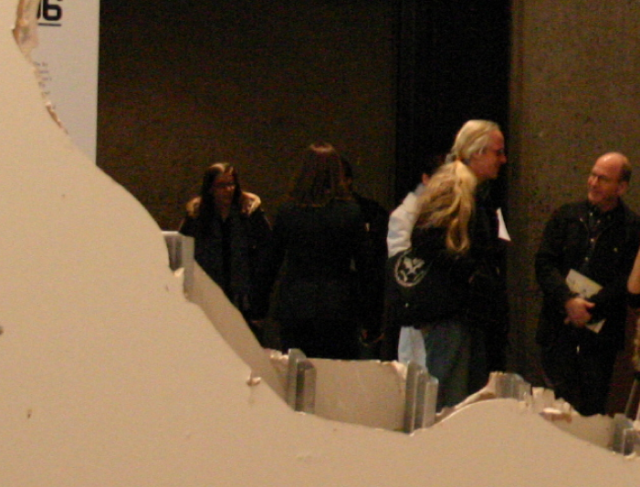
One of the keys to Jerry’s success with the Vulture threads is his thick skin. Many commenters, particularly at the beginning, wrote rather unkind things about him, the show and his involvement on it. “A lot of people, of course, hate art critics. I understand that,” he said. “You want to shoot us… shoot the art critic for being an arrogant blowhard who’s saying this is better than that-how can you possibly know? And a lot of people, early on, got on it to tell me that,” he said. “By not taking it personally and by taking every single thing that was written there seriously, I think that helped set a certain tone.”
He engaged with these people in the same way as he did with everyone else: by respectfully asking them questions, or by offering up a small, sharp dose of self-deprecation. To a commenter named NELSPHIGHBERG, Jerry wrote a short note: “I am sorry you don’t like my writing, my attempt at humor, or the reality TV show that I am on. I often do not like these things as well.” To a regular commenter named Lorax, he wrote: “I like the way that you write so I am sad to hear you say that the reality TV show that I am on is ‘ridiculous,’ ‘insipid,’ ‘spitefully edited,’ ‘sensational,’ and ‘content-false.’ You may be right.”
This, by the way-”you may be right”-is a classic Jerry Saltz move. I, an occasional commenter, at one point suggested that an artist who’d once worked for Jeff Koons had ripped off that artist’s style with one of her sculptures. Online, he disagreed politely and ended his comment with his oft-repeated phrase: “You may be right.” During our interview, when he asked me to remind him what comments I’d made, his response to that one was immediate. “Oh, no, you’re wrong, Alex!” he exclaimed, and laughed.
And he was right-I was wrong! But when he’d allowed weeks earlier that I might be right, it was a genuine rush. I’d made a valid point, maybe, and Jerry Saltz had acknowledged it. I was hooked; I knew I’d be back.
* * *
Much of what Jerry said in the course of our conversation suggested that he believes that each of the commenters, and anyone else for that matter, is just as qualified to talk about art as he is. “I’m ‘untrained,’ too,” he wrote in his first recap. “I have no degrees and never went to writing school. Like most people in the art world, I’m basically making this up as I go.” He has been, however, for quite some time a talented, established, and influential art critic; the commenters know it and he knows it, too. And the art world knows it. He and his wife, Times art critic Roberta Smith, often stomp through Chelsea galleries on the same days but separately, on different paths: she is cool and quiet, often in black, while he is constantly running into someone and having a boisterous conversation in someone’s echoey gallery. Their individual visits are regarded as equally important. This system of a critic’s visit and later review is the opposite of what Jerry has accomplished online. The sense of peership and continuous conversation on the comments pages and Facebook-created by the nature of the platform and executed and driven home by Jerry-was essential to the development of this strange little world.
Jerry himself doesn’t know whether the comments on his posts have actually “revolutionized” art criticism: like a proper critic, he knows the most important measure is the test of time. “If no one practices it after this, it’s not useful,” he said. “It was only useful to me and to the people that participated. That was it!”
At the end of our conversation, he offered a reminder. “You know this from my comments,” he said, which was true. “But you can write anything you want about me, and I don’t take it personally.”
Alexandria Symonds was rooting for Abdi.
Photo (top) by Man Bartlett from Flickr.
Photo (bottom) by Mark Berry from Flickr.
'Eat Pray Love': "NOT ENOUGH RAIN SEX"
Local douchebag reviews Eat Pray Love: “This is a staple of any good Nicholas Sparks novel-turned-movie: star-crossed couple gives in to their primal urges and they have slippery grabby-thigh make-outs in a torrential downpour. Instead we get Javier Bardem sauntering over to Julia Roberts while she’s sipping a glass of wine, contentedly reading a book, cooing, ‘It’s time.’ That’s not hot — that’s a goddamn Cialis commercial. You’re telling me it doesn’t rain in Bali? They have a Wet Season for Christ’s sake.”
The Summer Of Bedbugs
I think that, as New Yorkers, we should pretty much just accept that we’re all going to get bedbugs at some point soon. They are unavoidable, like Duane Reade or piss on the sidewalk. I’m itchy already.
"Preemptive Product Placement": The Celebrity Gift of Scorn
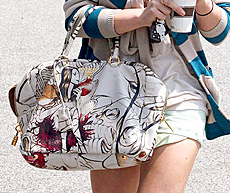
Delightful wee fashion fruit Simon Doonan alleges today that luxury brands make gifts of competitor’s products to undesirable tabloid stars. This is the greatest idea ever! I hope it’s true! I’m absolutely looking for ways to apply this technique of counter-branding in my own life.
Skanks Of New York
Whither our city’s slatterns, those squalid young things whose refusal to conform to proper notions of grooming and decorum somehow prove impossibly seductive to men who should know better than to be trapped by the promise of filthy, unbridled sexuality? Will they ever learn to dress better and take a shower and STOP FLAUNTING THEIR DIRTY DIRTY SEXBODIES? The Observer investigates.
Jersey Mayhem: Possible Gang Or Just Stupid Teenagers On Vandalizing Spree In Boonton Area

It is unclear whether or not a rash of public vandalism in northern New Jersey is “gang-related,” according to authorities. For the third time in less than a month, spray-painted graffiti was discovered in Boonton Township Monday morning: yet another display of swastikas, anti-police slogans and male genitalia, scrawled, perhaps frustratedly, in blue. “They keep drawing these swastikas and they keep drawing a picture of a fish with swastikas in it,” said officer Tom Cacciabeve, of the Boonton Township police department. “The word VOODOO keeps appearing also.’’
Complicating the investigation, similar markings were found nearby, and in the neighboring town of Boonton, in pink. (Though no depictions of female genitalia were reported.) The potentially mixed-gender vandals seem to hate a variety of car-makers, as a Honda was spray-painted with swastikas, a Chevy pick-up truck was lit on fire (Jesus!) and a Ford was tagged with the only-slightly-clever derogatory acronym, “Fix Or Repair Daily.” While the swastikas will not necessarily count as an act of anti-semitism, it seems pretty clear that police are in fact dealing with a gang problem here. The symbology is unmistakable. Apparently, Boonton and Boonton Township have been claimed as the turf of the of the notorious Rollin’ Nazi Fish Voodoo Cock-n-Balls Crew.
Cathy Is Not A Spinster, Damn It!
ACK! “A report in the ‘Arts, Briefly’ column on Friday about plans to end the comic strip ‘Cathy,’ after 34 years, misstated the title character’s marital status. Cathy married her on-again-off-again boyfriend, Irving, in 2005, so she has not turned out to be ‘perpetually single.’”
Goldman Sachs Banks Report: "Are We 'Turning Japanese'"?
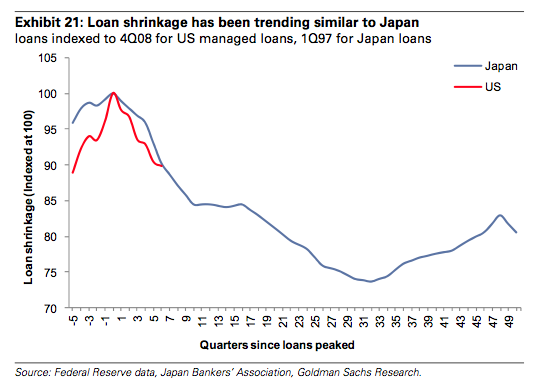
Today’s Goldman Sachs report on the U.S. banking industry has an amusing section where they have quite a number of graphs to prove that we’re not going to end up like Japan. They write: “The collapse of an enormous asset bubble, a banking and credit crisis, zero interest rates, central bank balance sheet expansion, and massive fiscal stimulus have caused some people to question whether the scenario here could continue to play out like Japan, where loans declined for eight years after the peak and interest rates remained near zero.” Loan shrinkage has indeed been trending just like Japan-but the U.S. cut interest rates and addressed a looming crisis much faster than Japan did. But what are banks doing now? They’re favoring securities over loans.
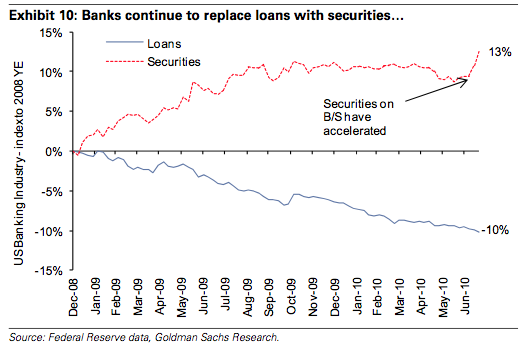
While very slight year-over-year growth in loans is expected to resume in 2011, loans have recently dipped and stuttered hard.
And while banks were making money off securities-”cash was swapped into securities at a very similar yield” as loans-now that party train is over. “As a result, as bank security portfolios continue to mature, banks are faced with the decision of buying expensive short-term assets or taking significant interest rate or duration risk given the lack of lending opportunities.” Oh yes, the “lack” of lending opportunities. That’s it.
